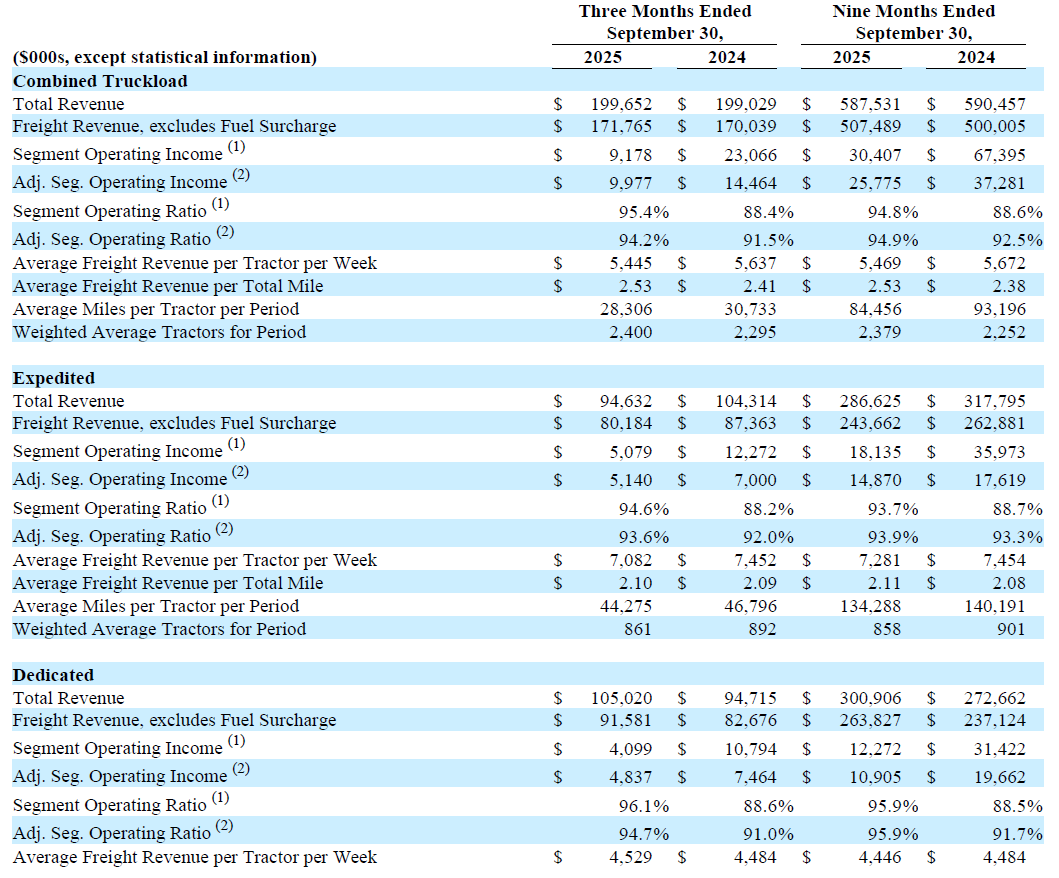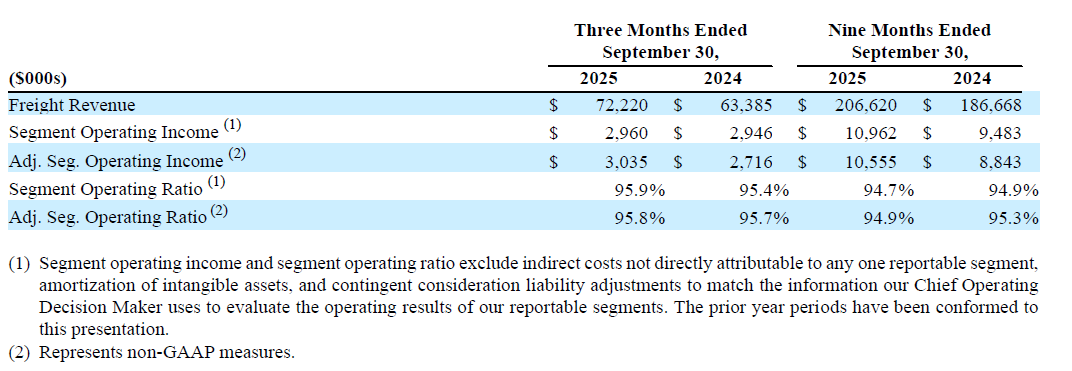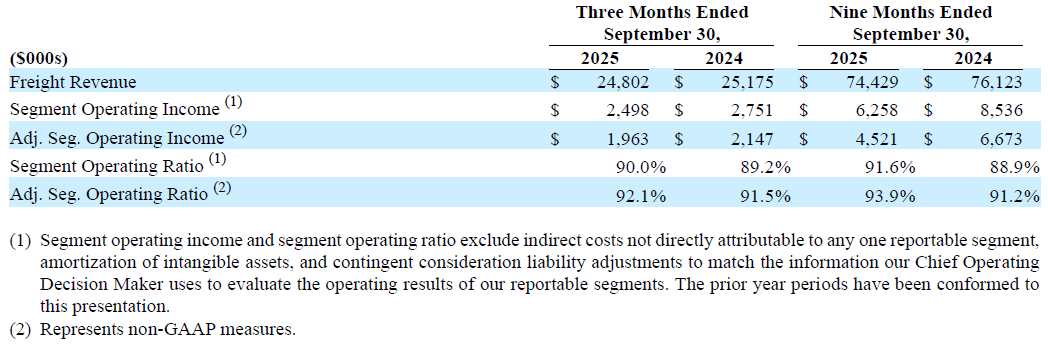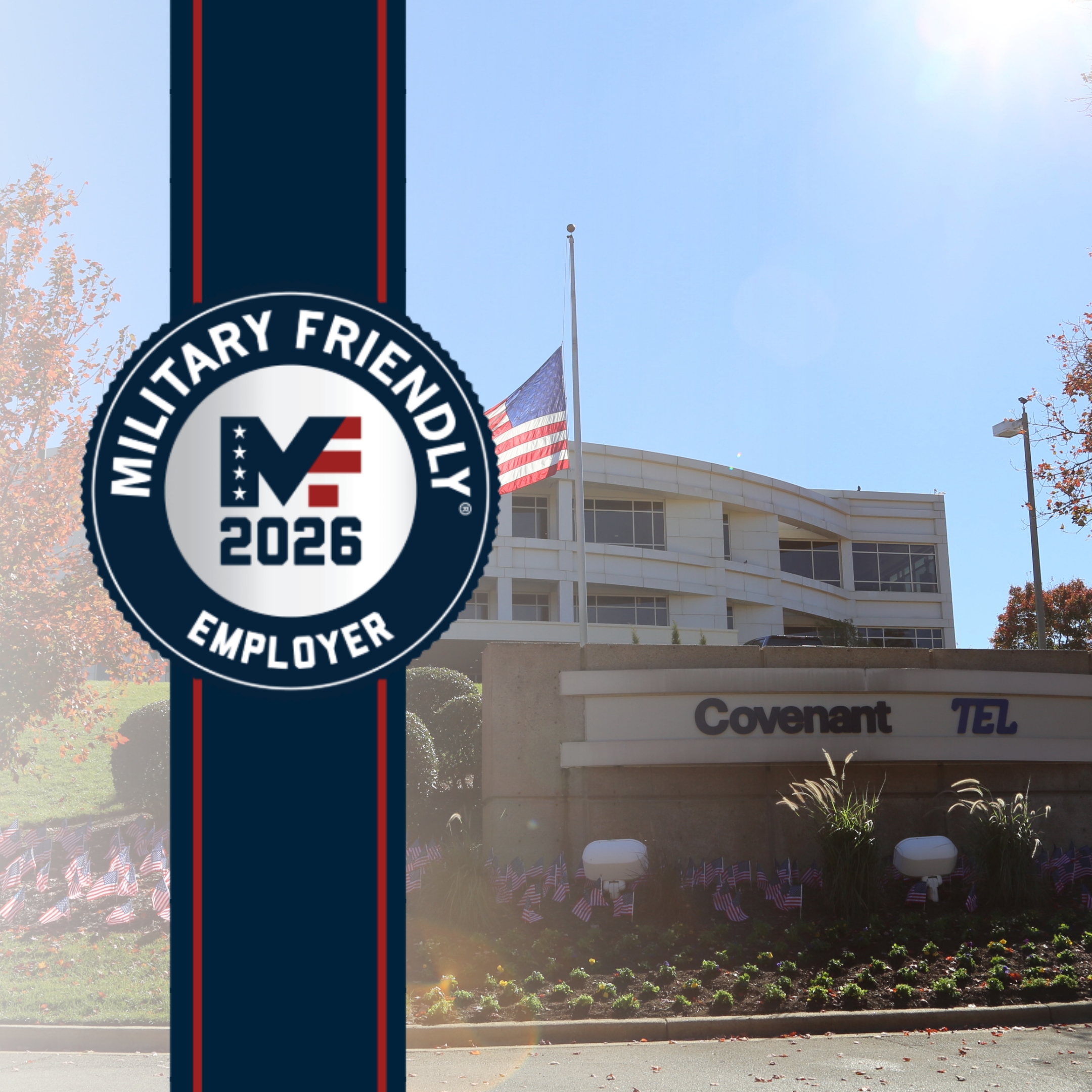CHATTANOOGA, TENNESSEE – October 22, 2025 - Covenant Logistics Group, Inc. (NYSE: CVLG) (“Covenant” or the “Company”) announced today financial and operating results for the third quarter ended September 30, 2025. The Company’s conference call to discuss the quarter will be held at 10:00 A.M. Eastern Time on Thursday, October 23, 2025.
Chairman and Chief Executive Officer, David R. Parker, commented: “Our third quarter results of $0.35 per diluted share, or $0.44 per diluted share on a non-GAAP adjusted basis, reflect essentially flat year-over-year performance in our asset-light business units and lower performance in our Truckload business units, mainly attributable to higher costs and under-utilized equipment. It was a busy quarter internally as we continued to invest in the future while managing costs during a prolonged period of overcapacity and muted demand.
“We continued to invest in and grow within certain industries that our dedicated fleet services with new start-up contracts, which weighed on third quarter margins but are expected to improve over time. Meanwhile, we continue to evaluate contracts in the rest of our Truckload business for improvement or exit. Overall, we expect modest contraction in our combined Truckload fleet and growth in our asset light segments as we allocate capital toward better returning business units. This process may impact quarterly financial results as we grow and shrink certain segments, adjust staffing needs, and dispose of equipment in potentially volatile used equipment markets.
“Our 49% equity method investment with Transport Enterprise Leasing (“TEL”) contributed pre-tax net income of $3.6 million, or $0.10 per share, compared to $4.0 million, or $0.11 per share, in the prior year quarter. The decline in TEL’s earnings is a result of customer bankruptcies that have accelerated over the past twelve months. While TEL’s overall business model remains healthy, we expect this headwind to continue for the foreseeable short term.
“Finally, I would be remiss not to acknowledge the unexpected passing of Lew Thompson, founder of Lew Thompson and Son Trucking Company, which we acquired in April 2023. Lew was a great friend and business partner, and his wisdom, humor, and storytelling will be missed by all. Lew was also a great mentor to the team that assumed day-to-day management of the business. We are confident this talented team will continue to ensure an exceptional customer experience, and we will honor Lew by continuing to serve our customers in a manner that would make him proud.”
Third Quarter Financial Performance:

Mr. Parker continued, “The third quarter included approximately $0.1 million in net items that have been excluded from adjusted financial results. Among these items was a $3.8 million gain from discontinued operations relating to a litigation settlement associated with our factoring business that was exited in 2020. Offsetting this gain was $3.7 million of expenses in severance and abandonment of certain underutilized leased facilities and systems related to exiting a large Managed Freight contract and the planned exit of legacy Dedicated contracts not providing sufficient returns. While these decisions were difficult and created a cost headwind in the quarter, we believe they needed to be made to improve the long-term cost profile of the Company. A detail of these costs is summarized in the table below.”

Truckload Operating Data and Statistics


Combined Truckload Revenue
Paul Bunn, the Company’s President commented on truckload operations, “For the quarter, total revenue in our truckload operations increased 0.3%, to $199.7 million. The increase in total revenue consisted of $1.7 million more freight revenue and $1.1 million less fuel surcharge revenue, which varies with the cost of fuel. Freight revenue grew by $1.7 million, or 1.0%, as a result of a 4.6% increase in the average tractor fleet, partially offset by lower equipment utilization.”
Expedited Truckload Revenue
Mr. Bunn added, “Freight revenue in our Expedited segment decreased $7.2 million, or 8.2%. Average total tractors decreased by 31 units, or 3.4%, to 861, compared to 892 in the prior year quarter. Average freight revenue per tractor per week decreased 5.0% as a result of a 5.4% decrease in utilization, partially offset by a small increase in freight revenue per total mile.”
Dedicated Truckload Revenue
“For the quarter, freight revenue in our Dedicated segment increased $8.9 million, or 10.8%. Average total tractors increased by 136 units, or 9.7%, to 1,539, compared to 1,403 in the prior year’s quarter. Average freight revenue per tractor per week increased 1.0% as a result of a 7.0% increase in freight revenue per total mile, partially offset by a 5.7% decrease in utilization.”
Combined Truckload Operating Expenses
Mr. Bunn continued, “Rising operating costs in our Truckload segment negatively impacted operating margins compared to the prior year quarter. Higher costs primarily include salaries, wages and related expenses, insurance, and both variable and fixed expenses necessary to seat and operate our equipment. Some expense increases were expected, as they relate to growth in high-service and lowmileage operations. The expense increases were partially offset by a 5.0% increase in freight revenue per total mile.
“Salaries, wages and related expenses increased year-over-year by 5 cents, or approximately 4%, on a per total mile basis. The increase was driven primarily from the year-over-year impact of significant growth in our dedicated protein supply chain business as well as employee separation costs incurred during the quarter. As we grow our dedicated fleet in niche services, it requires hiring and retaining skilled drivers and maintenance professionals to operate and maintain specialized equipment on loads that typically move heavy weights on non-paved roads with shorter lengths of haul, resulting in higher costs on a per total mile basis. Additionally, as the freight market improves and the driver market tightens, we anticipate that driver pay will continue to rise.
“Safety continues to be our priority as we consistently strive to raise our own standards by hiring highly qualified drivers, implementing proactive training sessions, and investing in and implementing safety equipment and technology. For the past several years, our safety statistics have been at or near the best in our history. However, given the self-insured portions, potential additional premiums in certain layers based upon experience, and limits of our insurance program, and the risk of extremely large awards and settlements in our industry (so-called “nuclear verdicts/settlements”), the amount of expense recognized from period to period can fluctuate materially. Insurance and claims expense for the current quarter was 4 cents per mile, or 24% higher than the prior year on a per total mile basis as a result of the incurrence and development of certain large claims. At a minimum, we anticipate the fourth quarter insurance expense to remain elevated compared to historical amounts.
“Equipment related expenses, including Operations and maintenance and Depreciation and amortization, increased approximately 8 cents per total mile, or approximately 15%, compared to the prior year quarter primarily due to an increased amount of unproductive equipment. In addition, costs associated with seating our equipment, including recruiting and onboarding expenses, contributed to the increase compared to the prior year. Going forward, as the driver market tightens, we anticipate the cost of recruiting and onboarding to remain elevated.
Managed Freight Segment

“For the quarter, Managed Freight’s freight revenue increased 14.0%, from the prior year quarter. Operating income improved 0.4% and adjusted operating income improved 11.7% compared to the third quarter of 2024. The growth in this segment is attributable to new business awarded in the year by a large customer that will no longer continue in the fourth quarter.”
Warehousing Segment

“For the quarter, Warehousing’s results were fairly comparable to the prior year with reduced revenue of $0.4 million and operating income and adjusted operating income reduced $0.3 million compared to the third quarter of 2024. In the fourth quarter, we areanticipating growth in this segment from a large new facility start up with an existing customer scheduled to begin in November 2025.”
Capitalization, Liquidity and Capital Expenditures
Tripp Grant, the Company’s Chief Financial Officer, added the following comments: “At September 30, 2025, our total indebtedness, composed of total debt and finance lease obligations, net of cash (“net indebtedness”), increased by $48.7 million to approximately $268.3 million as compared to December 31, 2024. In addition, our net indebtedness to total capitalization increased to 38.8% at September 30, 2025, from 33.4% at December 31, 2024.
“The increase to net indebtedness in the first three quarters of the year is primarily attributable to acquisition-related payments of $19.2 million and repurchasing approximately $36.2 million of common stock outstanding.
“At September 30, 2025, we had cash and cash equivalents totaling $2.7 million. Under our ABL credit facility, we had no outstanding borrowings, undrawn letters of credit outstanding of $19.9 million, and available borrowing capacity of $90.1 million.
“At the end of the quarter, we had $1.2 million in assets held for sale that we anticipate disposing of within twelve months. The average age of our tractors increased to 23 months compared to 20 months a year ago.
“Our expectations for net capital equipment expenditures in the fourth quarter is $15 million to $20 million.”
Outlook
Mr. Parker concluded, “Our outlook is impacted by both short-term and long-term factors. In the short term, we expect our Adjusted EPS for the fourth quarter to be sequentially lower than our Adjusted EPS for the third quarter. The reasons include expected lower profits from our minority investment in TEL attributable to credit losses in their small-carrier customer base, the impact of the U.S. government shutdown on our Department of Defense business, an expected increase in claims accruals, and loss of a large Managed Freight customer rolling off faster than the results of Star Logistics Solutions ramp. These negative factors are expected to more than outweigh our current expectation of a modest peak season boost to Expedited and Managed Freight.
“Over the intermediate to long term, I am more excited today than I have been in the last three years. From a freight environment perspective, capacity exits seem to be accelerating based on publicly announced bankruptcies of small carriers and our observation of TEL’s customer base, as well as increased enforcement of government policies concerning English language and non-domiciled drivers. In addition, there are potential demand drivers from unwinding excess inventories from import pull-forwards, tax and monetary policies, and clarification of trade policy. We have internal plans and opportunities to continue to grow certain dedicated and warehouse business that has the potential to yield acceptable margins and hold or downsize our other Truckload capacity until returns improve. To the extent we downsize capacity, we may experience severance, equipment disposal, and other costs that create uneven results in a given quarter but are expected to lead to stronger and more sustained results over time.
“In sum, we expect improving market conditions and our internal plan to produce operating leverage and higher earnings and return on capital over time, although individual quarters may be volatile. With an experienced team, an attractive business mix, and a disciplined approach to capital allocation, we believe Covenant is well-positioned for the future.”
Conference Call Information
The Company will host a live conference call tomorrow, October 23, 2025, at 10:00 a.m. Eastern time to discuss the quarter. Individuals may access the call by dialing 877-550-1505 (U.S./Canada) and 0800-524-4760 (International). An audio replay will be available for one week following the call at 800-645-7964, access code 3895#. For additional financial and statistical information regarding the Company that is expected to be discussed during the conference call, please visit our website at www.covenantlogistics.com/investors under the icon “Earnings Info.”
Covenant Logistics Group, Inc., through its subsidiaries, offers a portfolio of transportation and logistics services to customers throughout the United States. Primary services include asset- based expedited and dedicated truckload capacity, as well as asset-light warehousing, transportation management, and freight brokerage capability. In addition, Transport Enterprise Leasing is an affiliated company providing revenue equipment sales and leasing services to the trucking industry.Covenant's Class A common stock is traded on the New York Stock Exchange under the symbol, “CVLG.”
(1) See GAAP to Non-GAAP Reconciliation in the schedules included with this release. In addition to operating income, segment operating income, operating ratio, segment operating income, net income, and earnings per diluted share, we use adjusted operating income, adjusted segment operating income, adjusted operating ratio, adjusted segment operating ratio, adjusted net income, and adjusted earnings per diluted share, non-GAAP measures, as key measures of profitability. Adjusted operating income, adjusted segment operating income, adjusted operating ratio, adjusted segment operating ratio, adjusted net income, and adjusted earnings per diluted share are not substitutes for operating income, segment operating income, operating ratio, segment operating income, net income, and earnings per diluted share measured in accordance with GAAP. There are limitations to using non-GAAP financial measures. We believe our presentation of these non-GAAP financial measures are useful because it provides investors and securities analysts with supplemental information that we use internally for purposes of assessing profitability. Further, our Board and management use non-GAAP operating income, segment operating income, operating ratio, segment operating income, net income, and earnings per diluted share measures on a supplemental basis to remove items that may not be an indicator of performance from period-to-period. Although we believe that adjusted operating income, adjusted segment operating income, adjusted operating ratio, adjusted segment operating ratio, adjusted net income, and adjusted earnings per diluted share improves comparability in analyzing our period-to-period performance, they could limit comparability to other companies in our industry, if those companies define such measures differently. Because of these limitations, adjusted operating income, adjusted segment operating income, adjusted operating ratio, adjusted segment operating ratio, adjusted net income, and adjusted earnings per diluted share should not be considered measures of income generated by our business or discretionary cash available to us to invest in the growth of our business. Management compensates for these limitations by primarily relying on GAAP results and using non-GAAP financial measures on a supplemental basis.
This press release contains certain statements that may be considered forward-looking statements within the meaning of Section 27A of the Securities Act of 1933, as amended, and Section 21E of the Securities Exchange Act of 1934, as amended, and such statements are subject to the safe harbor created by those sections and the Private Securities Litigation Reform Act of 1995, as amended. Such statements may be identified by their use of terms or phrases such as “expects,” “estimates,” “projects,” “believes,” “anticipates,” “plans,” “could,” “continue,” “would,” “may,” “will,” "intends," “outlook,” “focus,” “seek,” “potential,” “mission,” “continue,” “goal,” “target,” “objective,” derivations thereof, and similar terms and phrases. Forward-looking statements are based upon the current beliefs and expectations of our management and are inherently subject to risks and uncertainties, some of which cannot be predicted or quantified, which could cause future events and actual results to differ materially from those set forth in, contemplated by, or underlying the forward-looking statements. In this press release, statements relating to equipment age, net capital expenditures and related priorities, benefits, and returns, capital allocation alternatives, expectations for the general freight market, our ability to grow our dedicated fleet, the driver market, including driver pay and recruiting, future insurance and claims expense, margin, and return on capital, future repurchases under the stock repurchase program, if any, progress toward our strategic goals and the expected impact of achieving such goals, and the statements under “Outlook” are forward-looking statements. The following factors, among others could cause actual results to differ materially from those in the forward-looking statements: Our business is subject to economic, credit, business, and regulatory factors affecting the truckload industry that are largely beyond our control; We may not be successful in achieving our strategic plan; We operate in a highly competitive and fragmented industry; We may not grow substantially in the future and we may not be successful in improving our profitability; We may not make acquisitions in the future, or if we do, we may not be successful in our acquisition strategy; The conflicts in Ukraine and the Middle East, expansion of such conflicts to other areas or countries or similar conflicts, as well as rising tensions between China and Taiwan, could adversely impact our business and financial results; Increases in driver compensation or difficulties attracting and retaining qualified drivers could have a materially adverse effect on our profitability and the ability to maintain or grow our fleet; Our engagement of independent contractors to provide a portion of our capacity exposes us to different risks than we face with our tractors driven by company drivers; We derive a significant portion of our revenues from our major customers; Fluctuations in the price or availability of fuel, the volume and terms of diesel fuel purchase commitments, surcharge collection, and hedging activities may increase our costs of operation; We depend on third-party providers, particularly in our Managed Freight segment; We depend on the proper functioning and availability of our management information and communication systems and other information technology assets (including the data contained therein) and a system failure or unavailability, including those caused by cybersecurity breaches internally or with third-parties, or an inability to effectively upgrade such systems and assets could cause a significant disruption to our business; If we are unable to retain our key employees, our business, financial condition, and results of operations could be harmed; Seasonality and the impact of weather and climate change and other catastrophic events affect our operations and profitability; We self-insure for a significant portion of our claims exposure, which could significantly increase the volatility of, and decrease the amount of, our earnings; Our self-insurance for auto liability claims and our use of captive insurance companies could adversely impact our operations; We have experienced, and may experience additional, erosion of available limits in our aggregate insurance policies; We may experience additional expense to reinstate insurance policies due to liability claims; We operate in a highly regulated industry; If our independent contractor drivers are deemed by regulators or judicial process to be employees, our business, financial condition, and results of operations could be adversely affected; Developments in labor and employment law and any unionizing efforts by employees could have a materially adverse effect on our results of operations; The Compliance Safety Accountability program adopted by the Federal Motor Carrier Safety Administration could adversely affect our profitability and operations, our ability to maintain or grow our fleet, and our customer relationships; Receipt of an unfavorable Department of Transportation safety rating at any of our motor carriers could have a materially adverse effect on our operations and profitability; Compliance with various environmental laws and regulations; Regulatory changes related to climate change could increase our costs significantly; Changes to trade regulation, quotas, duties, or tariffs; Litigation may adversely affect our business, financial condition, and results of operations; Conflicting views on environmental, social and governance matters may have a negative impact on our business, impose additional costs on us, and expose us to additional risks; A large-scale outbreak of avian flu or related illness among the nation’s poultry flock may adversely affect the revenues of our Dedicated segment; Our ABL credit facility and other financing arrangements contain certain covenants, restrictions, and requirements, and we may be unable to comply with such covenants, restrictions, and requirements; In the future, we may need to obtain additional financing that may not be available or, if it is available, may result in a reduction in the percentage ownership of our stockholders; Our indebtedness and finance and operating lease obligations could adversely affect our ability to respond to changes in our industry or business; Our profitability may be materially adversely impacted if our capital investments do not match customer demand or if there is a decline in the availability of funding sources for these investments; Increased prices for new revenue equipment, design changes of new engines, future uses of autonomous tractors, volatility in the used equipment market, decreased availability of new revenue equipment, and the failure of manufacturers to meet their sale or trade-back obligations to us could have a materially adverse effect on our business, financial condition, results of operations, and profitability; Our 49% owned subsidiary, Transport Enterprise Leasing, faces certain additional risks particular to its operations, any one of which could adversely affect our operating results; We could determine that our goodwill and other intangible assets are impaired, thus recognizing a related loss; Our Chairman of the Board and Chief Executive Officer and his wife control a large portion of our stock and have substantial control over us, which could limit other stockholders' ability to influence the outcome of key transactions, including changes of control; Provisions in our charter documents or Nevada law may inhibit a takeover, which could limit the price investors might be willing to pay for our Class A common stock; The market price of our Class A common stock may be volatile; We cannot guarantee the timing or amount of repurchases of our Class A common stock, or the declaration of future dividends, if any; Changes in taxation could lead to an increase of our tax exposure; If we fail to maintain effective internal control over financial reporting in the future, there could be an elevated possibility of a material misstatement, and such a misstatement could cause investors to lose confidence in our financial statements, which could have a material adverse effect on our stock price; and The effects of a widespread outbreak of an illness or disease, or any other public health crisis, as well as regulatory measures implemented in response to such events, could negatively impact the health and safety of our workforce and/or adversely impact our business and results of operations. The declaration of future dividends is subject to approval of our board of directors and various risks and uncertainties, including, but not limited to: our cash flow and cash needs; compliance with applicable law; restrictions on the payment of dividends under existing or future financing arrangements; changes in tax laws relating to corporate dividends; deterioration in our financial condition or results: and those risks, uncertainties, and other factors identified from time-to-time in our filings with the Securities and Exchange Commission. Readers should review and consider these factors along with the various disclosures by the Company in its press releases, stockholder reports, and filings with the Securities and Exchange Commission. We disclaim any obligation to update or revise any forward-looking statements to reflect actual results or changes in the factors affecting the forward-looking information.
For further information contact:
M. Paul Bunn, President
PBunn@covenantlogistics.com
Tripp Grant, Chief Financial Officer
TGrant@covenantlogistics.com
For copies of Company information contact:
Brooke McKenzie, Executive Administrative Assistant
BMcKenzie@covenantlogistics.com





.png)
